List of memorial stones in Vienna-Liesing
The list of memorial stones in Vienna-Liesing contains the memorial stones and memorial plaques in the 23rd district of Vienna , Liesing , which remember the fate of the people who were murdered, deported, expelled or driven to suicide by the National Socialists . The laying and construction is carried out by the Stones of Remembrance Association in Liesing .
concept
The concept of Wiener remembrance and memorial stones based on the pitfalls of Gunter Demnig and from this as plagiarism called. The Liesing memorial stones differ from Demnig's stumbling blocks (a) in their size, (b) in that they also honor two or more people on a memorial stone, (c) that they were made by machine and not by hand.
Memorial stones
The table is partially sortable; the basic sorting is done alphabetically according to the family name. When it comes to numbering, a distinction is made between memorial stones (S) and memorial plaques (T).
![]() Map with all coordinates: OSM | WikiMap
Map with all coordinates: OSM | WikiMap
| image | Surname | No | Location | Life |
|---|---|---|---|---|
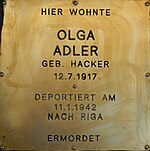
|
Olga Adler | P. 53 | Autofabrikstrasse 5 |
Olga Adler (born July 12, 1917) was deported to Riga on January 11, 1942 and murdered. |

|
Ettel Amster (née Appermann) |
S 20 | Breitenfurter Strasse 365 |
Ettel Amster (born March 29, 1867 in Jarosław, Galicia) was deported together with her husband Samuel on February 6, 1942 with Transport 16 from Vienna to Riga and murdered there. The couple's only son managed to flee to England in time. |
| Samuel H. Amster | Samuel Amster (born June 15, 1868 in Dobromyl, Galicia) was a merchant in Atzgersdorf. He ran a furniture shop and a money lending business and was known as a benefactor in Atzgersdorf and Liesing, as his modalities of payment made him consider the economic situation of his borrowers. He deferred repayment of debtors who had become unemployed until they found a job again. His fellow citizens showed him great respect for this. The Amstergasse in Atzgersdorf is named after him. He was deported to Riga on February 6, 1942, and murdered there. | |||

|
Martha Arnstein | T 2 | Kirchenplatz 1 (on the facade of Atzgersdorfer Church) |
Martha Arnstein (born January 22, 1910) lived at Breitenfurter Strasse 38 (today 282) and was deported from Vienna to Lodz with Transport 9 on October 28, 1941. |
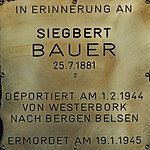
|
Siegbert Bauer | P. 46 | Ketzergasse 60 |
Siegbert Bauer (born July 25, 1881) was deported from Westerbork to Bergen Belsen on February 1, 1944 and murdered on January 19, 1945. |
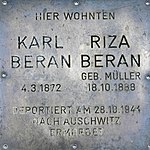
|
Karl Beran | S 6 | Bricklayer Lange Gasse 85 |
Karl Beran (born March 4, 1872 in Vienna) worked for the Österreichische Kreditanstalt Wiener Bankverein. With his wife Risa he had a daughter, Gertrude Ilka Beran, who was born on November 1, 1908 and died in 1924. Karl Beran retired in 1938 and received an old-age pension of 247.35 RM per month, the family also owned domestic and foreign Austrian government bonds worth around 8,000 RM. On September 30, 1938, the Beran family had to leave their apartment. First Karl and Risa Beran moved to the 2nd district of Vienna, in 1940 to the 4th district and in December 1941 back to the 2nd district. On July 22, 1942, the couple were deported to Theresienstadt (Transport No. 33) and from here they were deported to Auschwitz on October 28, 1944 , where both were murdered, probably on the day of their arrival. |
| Risa Beran (née Müller) |
Risa Beran (born October 18, 1888) lived with her husband Karl Beran in a rented apartment in Mauer (Lange Gasse 85), they had to leave this apartment on September 30, 1938 and they first moved to the 2nd district of Vienna ( Obere Donaustraße 49/26), on July 24, 1940 another move took place in the 4th district of Vienna (Brahmsplatz 8/1/111/6), only a few months later, on December 2, 1941, another move took place again in the 2nd district of Vienna (Czerninplatz 2/11/11/36). On July 22, 1942, she and her husband Karl were deported from Vienna to Theresienstadt on Transport No. 33 and from there to Auschwitz on October 28, 1944 . Of the 18,402 people who were deported in eleven transports to Auschwitz-Birkenau between September 28 and October 28, 1944, only 1,574 survived. Risa Beran did not survive the deportation and was probably murdered on the day of her arrival in Auschwitz. | |||

|
Katharina Biedermann | P 49 | Endresstrasse 93-95 |
Katharina Biedermann (born June 14, 1884) was deported to Theresienstadt on September 24, 1942, from there to Auschwitz on January 23, 1943 and murdered. |

|
Hedy Blum | S 2 | 316th Street |
Hedy Blum (born on August 23, 1931) was deported to the Maly Trostinez extermination camp on August 17, 1942, when she was not yet 11 , where she was murdered on August 21, 1942, the day she arrived at the camp. |
| Sidonie Blum (née Kornitzer) |
Sidonie Blum (born on January 6, 1898) lived with her daughter Hedy Blum at Breitenfurter Straße 76 (today no. 320). In 1939 they were forced to leave their apartment and were taken to a collective apartment in the 2nd district of Vienna (Czerningasse 15), where they lived with 3 other families for 3 years. On August 17, 1942, they were deported to the Maly Trostinez extermination camp, where they were murdered on arrival on August 21, 1942. She was Mathilde Frischwasser's sister. Her husband Heinrich Blum and her son Nathan Hans Blum managed to escape, both of whom died in Israel. | |||

|
Ernst Buchbinder | P 39 | Paminagasse 42 |
Ernst Buchbinder (born June 13, 1896) was deported to Theresienstadt on March 30, 1943 and murdered in Auschwitz. |

|
Johann Broda | T 4 | Fröhlichgasse 15 (on the facade of the house) (previously relocated to Fröhlichgasse 42 due to an incorrect address assignment) |
Johann Broda (born November 14, 1910) was deported from Pithiviers to Auschwitz on June 25, 1942 and murdered on August 16, 1942. |
| Margarete Broda | Margarete Broda (born September 9, 1907) was deported to Maly Trostinec on June 2, 1942 and murdered. | |||
| Olga Broda | Olga Broda (born August 31, 1904) was deported to Maly Trostinec on June 2, 1942 and murdered. | |||
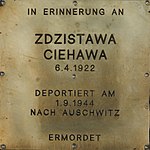
|
Zdzistawa Ciehawa | P. 55 | Franz-Parsche-Gasse 6 |
Zdzistawa Ciehawa (born April 6, 1922) was deported to Auschwitz on September 1, 1944 and murdered. |

|
Eduard Czerner | S 14 | Breitenfurter Strasse 350 |
Eduard Czerner (born March 22, 1883 in Brody , Ukraine) last lived in Vienna 2, Czerningasse 8. Together with his wife Gisela, he was deported to the Kielce ghetto on February 19, 1941 on Transport No. 2 and murdered. |
| Gisela Czerner (née Klein) |
Gisela Czerner (born June 15, 1885 in Kis Szilva , Hungary) was born as Gisela Klein; her parents are Berta and Eduard Klein. She was married to Eduard Czerner and lived with him in Liesing . Together with him, she was deported to the Kielce ghetto on Transport No. 2 on February 19, 1941 , and murdered. The biographical information about Gisela Czerner based on the testimony of her daughter, Julie Cohen, a photograph of her and the witness report from 1978 are archived in the Yad Vashem digital database and accessible online. | |||

|
Adolf Denkscherz | S 12 | Endresstrasse 16 |
Adolf Denkscherz (born December 21, 1899) was a mechanic. He was married to Hilda Geiger (born on September 14, 1894); the marriage was divorced in 1927. Denkscherz was deported on October 28, 1941 with Transport 9 from Vienna to the Łódź Ghetto , where he was killed. His number during the transport was 941. |

|
Auguste Drill (née Taussig) |
S 7 | Bricklayer Lange Gasse 62 |
Auguste Drill (born March 18, 1887 in Vienna) had to leave the Wall on August 17, 1941 together with her husband, Wilhelm Drill. The couple moved to Rotenturmstrasse 21 in the 1st district and were deported from there on April 27, 1942 with Transport No. 18 to Włodawa in Poland. |
| Wilhelm Drill | Wilhelm Drill (born August 31, 1873 in Paasdorf ) received his doctorate in medicine from the University of Vienna and then worked for five years as a secondary doctor at the Vienna General Hospital. In 1903/1904 he opened a practice in Mauer . He was very respected here and was considered a philanthropist. From August 1914 to November 1918 he was the hospital commandant in charge of the reserve hospital in Uscca and Deroleta in Bosnia, for which he received several prestigious awards. On April 6, 1925, he married Auguste Taussig. In 1936, the community council of Mauer decided unanimously to obtain the title of Medical Councilor for Wilhelm Drill. After the Anschluss, only Jewish citizens were allowed to be treated in his practice. Due to the Nuremberg Laws , this had to be closed on September 30, 1938. Wilhelm Drill was forced to adopt the middle name Israel. He and his wife had to leave Mauer on August 17, 1941, and the couple moved to Vienna's 1st district (Rotenturmstrasse 21). In February 1942 they were taken to a camp in the 2nd district, on Sperlgasse. From there, the deportation took place with Transport No. 18 on April 27, 1942 to Włodawa in Poland. Wilhelm Drill was pronounced dead on May 8, 1945. | |||

|
Erich fresh water | S 17 | 389 street |
Erich Frischwasser (born February 27, 1932) was the son of Sam Shalo (also: Schulem) and Mathilde Frischwasser. While his father (1900–1989) and his brother Alexander (1927–2006) survived in the USA , Erich and his mother were deported to Poland and on April 4, 1943, as part of the evacuation of the Zloczów ghetto, along with several hundred other victims of the Holocaust murdered by SS troops in a mass shooting. |
| Mathilde Frischwasser (née Kornitzer) |
Mathilde Frischwasser (born on January 21, 1899) ran a textile business. Due to the racial madness of the Nazi regime , she was abducted to Poland together with her eleven-year-old son Erich, and both were murdered on April 4, 1943 in Zloczów as part of mass shootings. She was Sidonie Blum's sister. | |||

|
Helene Fuchs (née Grüner) |
P 32 | Paul-Katzberger-Gasse 9 |
Helene Fuchs (born June 5, 1897 in Vienna) was a Polish citizen. She had lived in Rodaun since 1930, initially at Elisenstrasse 77. By profession she was a homeworker (crocheting and embroidering traditional costumes) and a housewife. She married Aaron Fuchs (born on January 7, 1891) and then lived in Untere Viaduktgasse 13. The marriage did not last and was divorced. Aaron Fuchs visited the family only sporadically and disappeared from Vienna after the February fighting in 1934 . In 1939 he reported from the Soviet Union, which led to the whole family being summoned to the Gestapo. There were no more signs of life from Aaron Fuchs.
The marriage had two children: Ruth Fuchs (born on January 22, 1931) and Karl Fuchs (born on December 19, 1925). Helene Fuchs lived as a single parent in a one-room apartment. She eke out her existence as a cleaning lady and laundress for the neighbors. She lived in dire poverty and therefore both children were taken to an orphanage from 1933/34. Karl was taken to a home on Goldschlagstrasse, his sister to a home in Döbling. Since Helene Fuchs was completely destitute, she could not emigrate either. Helene and Ruth were moved to separate collective apartments in the 2nd district. On August 31, 1942, she and Ruth were deported to Maly Trostinec on Transport 39, Da 225 and murdered on September 4, 1942. Karl Fuchs managed to escape to Palestine. |
| Ruth Fuchs | Ruth Fuchs (born on January 22, 1931) was deported to Maly Trostinec on August 31, 1942 with her mother Helene Fuchs on transport 39 Da 225 and murdered on September 4, 1942. | |||

|
Rudolf Fuchs | P 26 | Breitenfurter Strasse 278 |
Rudolf Fuchs (born on July 23, 1892 in Jihlava ) lived, among other places, at Breitenfurter Strasse 34 (today No. 278), but during the war in Prague (Vezenska 9). On August 18, 1944, he was deported from Prague to the Theresienstadt ghetto on Transport Ef (his number on the transport was 11); on September 29, 1944, he was transferred to Auschwitz on Transport El (his number on the transport was 291) where he was murdered. |
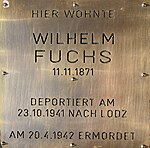
|
Wilhelm Fuchs | P. 24 | Breitenfurter Strasse 292 |
Wilhelm Fuchs (born November 11, 1871 in Holíč ) lived at Breitenfurter Straße 48 (today No. 292) in Vienna. On October 23, 1941, he was taken from the collection point Kleine Sperlgasse 2A (a school in Vienna's 2nd district) to the Aspangbahnhof and from there deported from Vienna to Łódź on transport 8, train Da 9 (his number on the transport was 72) , where he arrived on October 24, 1941. Murdered on April 20, 1942, he was murdered in Łódź. |

|
Ferdinand goose | P 37 | Ruzickagasse 78 |
Ferdinand Gans (born March 19, 1867) was deported to Lodz on October 28, 1941 and murdered. |
| Flora goose | Flora Gans (born April 1, 1890): dates of deportation and death are unknown. | |||

|
Rosa Gerstl (née Neumann) |
P 29 | Karl-Heinz-Strasse 28 |
Rosa Gerstl (born on January 4, 1889) was deported to Malines / Auschwitz-Birkenau on April 19, 1943. |
| Arnold Gerstl | Arnold Gerstl (born on May 13, 1886) was deported to Drancy / Auschwitz-Birkenau on August 12, 1942. | |||

|
Karl Griesbach | S 10 | Taglieberstrasse 11 |
Karl Griesbach (born July 25, 1904 in Vienna) was an Austrian communist and resistance fighter against the Nazi regime. He was arrested by the Vienna Gestapo for "preparation for high treason" , interrogated and deported to the Börgermoor concentration camp . He died there in 1944 or 1945 and was pronounced dead in 1950. |
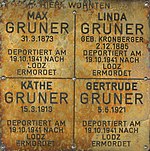
|
Max Gruner | P 43 | Triester Strasse 150 |
Max Gruner (born March 31, 1873) was deported to Lodz on October 19, 1941 and murdered. |
| Linda Gruner (née Kronberger) |
Linda Gruner (born December 2, 1885) was deported to Lodz on October 19, 1941 and murdered. | |||
| Käthe Gruner | Käthe Gruner (born March 15, 1913) was deported to Lodz on October 19, 1941 and murdered. | |||
| Gertrude Gruner | Gertrude Gruner (born May 5, 1921) was deported to Lodz on October 19, 1941 and murdered. | |||

|
Ernst Goldstein | P. 40 | Autofabrikstrasse 1 |
Ernst Goldstein (born June 6, 1914) was murdered in Auschwitz on April 28, 1944. |
| Rosa Goldstein | Rosa Goldstein (born May 26, 1878) was deported to Izbica on June 5, 1942 and murdered. | |||

|
Helene Hatschek (née Porkorny) |
S 13 | Endresstrasse 16 |
Helene Hatschek (born February 25, 1880) was the widow of the respected Atzgersdorf doctor Rudolf Hatschek , who died in 1939. She and her son had to move from Bahnstrasse 18 (today Endresstrasse 16) and came to Vienna's 9th district (Rossauer Gasse 3). On June 2, 1942, she and her son Wilhelm were deported on Transport 24 Zug Da 205 from Vienna to Minsk to the Maly Trostinez extermination camp, where they were murdered. |
| Wilhelm Hatschek | Wilhelm Hatschek (born on April 23, 1916) was taken with his mother on June 2, 1942 with Transport 24 Zug Da 205 from Vienna to Minsk, where both were murdered in the Maly Trostinez extermination camp . | |||

|
Rudolf Hawel | P. 54 | Carlbergergasse 45 |
Rudolf Hawel (born April 11, 1891) was deported to Dachau on June 15, 1938 as part of the "police security detention" and murdered in Mauthausen on February 1, 1940. |
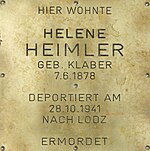
|
Helene Heimler (née Klaber) |
P 48 | Jesuitensteig 19 |
Helene Heimler (born June 7, 1878) was deported to Lodz on October 28, 1941 and murdered. |
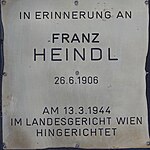
|
Franz Heindl | P.34 | Siebenhirtenstrasse 4 |
Franz Heindl (born June 26, 1906 in Liesing) was married and had a son. He worked at the VARTA accumulator factory as an unskilled worker.
Franz Heindl was sentenced to death by the People's Court on November 27, 1943 for “preparing for high treason” for working for the KPÖ. In the same process, his brother Michael Heindl was sentenced to death. Both were guillotined on March 13, 1944 in the Vienna Regional Court. |

|
Michael Heindl | P. 33 | Josef-Kutscha-Gasse 18 |
Michael Heindl (born September 29, 1901 in Vienna) was married and had a daughter. By profession he was a railroad worker and until 1934 a social democratic functionary, councilor, welfare officer, train driver and sports director of the Republican Protection Association in Liesing.
Michael Heindl was sentenced to death by the People's Court on November 27, 1943 for “preparing for high treason” for working for the KPÖ. In the same trial, his brother Franz Heindl was sentenced to death. Both were guillotined on March 13, 1944 in the Vienna Regional Court. Together with the brothers, 14 other resistance fighters were murdered by the Nazi regime that day, including their co-defendants Franz Anderle, Franz Hauer and Therese Klostermann. The sixth defendant, Max Schrems, was beheaded on April 7, 1944. The two brothers were not only arrested, sentenced and executed together, they were also buried in the same grave - in the shaft graves of group 40 (row 24 / grave 204) of the Vienna Central Cemetery. A street in Liesing was named after the Heindl brothers. |

|
Leopold Hofmann | S 11 | Taglieberstrasse 1 |
Leopold Hofmann (born September 8, 1900) was a chauffeur and lived in the Atzgersdorf district of Liesingen . He was arrested in January 1944 for working for the KPÖ and deported to the Flossenbürg concentration camp on August 14, 1944 . He died on March 19, 1945 in the Hersbruck subcamp. |

|
Alfred Kleppner | P. 30 | Auer-Welsbach-Strasse 53 |
Alfred Kleppner (born December 9, 1903) was an actor (Alfred Alfner), on November 11, 1943 with Transport 461 to Theresienstadt (No. 1041) and on October 19, 1944 with Transport Es to Auschwitz (No. 92) deported. |

|
Therese Klostermann (née Lhotzky) |
S 1 | Carlbergergasse 39 |
Therese Klostermann (born July 11, 1913 in Vienna) was an Austrian worker and resistance fighter against the Nazi regime . She collected donations for the relatives of the politically imprisoned, was sentenced to death by the Nazi judiciary on November 27, 1943, together with five other resistance fighters , and was executed with the guillotine in the Vienna Regional Court on March 13, 1944 . |

|
Adele Kohn (née Kominik) |
P. 36 | Schlossgartenstrasse 14 |
Adele Kohn (born April 20, 1922) was deported to Theresienstadt on May 15, 1942 and murdered in Lublin. |
| Rosa Kominik (née Kirschenbaum) |
Rosa Kominik (born May 19, 1883) was deported to Theresienstadt on May 15, 1942 and murdered in Lublin. | |||

|
Ernst Kronberger | P 42 | Triester Strasse 150 |
Ernst Kronberger (born October 16, 1891) was deported to Nisko on October 20, 1939 and murdered. |
| Klara Kronberger (née Buchbinder) |
Klara Kronberger (born March 12, 1894) was deported to Riga on December 3, 1941 and murdered. | |||

|
Philip Kronberger | P 51 | Rudolf-Waisenhorn-Gasse 86 |
Philip Kronberger (born on September 19, 1869) was deported to Dachau on June 25, 1938 and murdered in Buchenwald on December 21, 1938. |

|
Cäcilie Kunke (née Schiffer) |
S 4 | Kroißberggasse 8 |
Cäcilie Kunke (born May 24, 1880 in Hindenburg), often called Cilli or Cilla, was the wife of Norbert Kunke (1871–1938), most recently director of insurance for Austrian consumer associations in Vienna. Her husband retired in 1934 and died in 1938. The couple had three children: Alice (dates and fate unknown), who attended a theater school and was called Kordaszewska after their marriage, Herta Gertrude (1901–1942), a French teacher, and Hans Kunke (1906-1940), an insurance officer. As far as can be seen, the entire family was murdered by the Nazi regime. On October 20, 1938, Cäcilie Kunke and her daughter Herta Gertrude had to leave their villa and they came to Vienna's 4th district (Wiedner Hauptstrasse 15/7). Both tried to be able to leave the German Reich, but this did not succeed. In 1942 another resettlement took place in the 20th district (Treustraße 2/5) and finally in the 2nd district (Sperlgasse 2A). The villa in Kroißberggasse was initially sold by the Kunkes to the German Reich; in November 1942 the villa and the adjacent property (also owned by the Kunke family) were confiscated as anti-people and subversive assets in favor of the German Reich. With the decision of the District Court of Liesing on February 24, 1977, Cäcilia Kunke's shares in the villa and the Weingarten property were incorporated in the land register as a reversal property for the Republic of Austria. Cäcilie Kunke and her daughter were deported to Auschwitz on July 17, 1942 and murdered there. |
| Hans Kunke | Hans Kunke (born December 12, 1906 in Biała ) was an insurance officer and resistance fighter against the Nazi regime. He was a member of the Socialist Workers Youth. Like his siblings, Hans was also very musically gifted (he played the piano and was a very good baritone singer), from 1930 to 1934 he wrote political reviews (well-known melodies were given a political text or political poems were set to music). In the socialist youth workers he met his future wife, Stefanie Kunke , whom he married on September 28, 1934. The couple moved to the 7th district of Vienna (Zieglergasse 46). The State Police made their first arrest on September 28, 1936, they were convicted, but were released again under the amnesty law. On May 15, 1938, the couple was arrested again. Hans Kunke first came to the Dachau concentration camp and from there to the Buchenwald concentration camp , where he had to carry stones, although according to eyewitness reports he was no longer physically able to do so. Hans Kunke was shot dead while running towards barbed wire on October 30, 1940 (at the age of 33). | |||
| Herta Gertrude Kunke | Herta Gertrude Kunke (born April 17, 1901) was a French teacher. She lived with her mother in Mauer near Vienna and was deported with her to Auschwitz on July 17, 1942 . In 1955 she was declared dead on May 8, 1945. | |||

|
Stefanie Kunke (née Jelinek) |
S 3 | Bricklayer Lange Gasse 47 |
Stefanie Kunke (born December 26, 1908 in Vienna) was an Austrian teacher and resistance fighter against the Nazi regime . Like her husband Hans Kunke , she was arrested, deported and murdered at the age of 34 on February 14, 1943 in the Auschwitz-Birkenau concentration camp . |

|
Karl Lasser | P. 38 | Reiterberggasse 3 |
Karl Lasser (born February 26, 1908) was deported to Sachsenhausen on March 30, 1940 and murdered on May 8, 1940. |

|
Sophie Lechner | P 47 | Bricklayer Lange Gasse 90 |
Sophie Lechner (born October 3, 1880) was deported to Maly Trostinec on August 31, 1942 and murdered on September 4, 1942. |

|
Anna Ledvenyi (née Amster) |
S 21 | Breitenfurter Strasse 365 |
Anna Ledvenyi (born on April 16, 1899) was deported to Žilina / Slovakia on September 25, 1942 and murdered. |
| Ludwig (Lajos) Ledvenyi | Ludwig (Lajos) Ledvenyi (born June 15, 1896) was deported to Žilina / Slovakia and murdered in Auschwitz on February 8, 1943. | |||
| Felix Ledvenyi | Felix Ledvenyi (born December 9, 1921) was deported to Sered / Slovakia and murdered. | |||
| Ilona Ledvenyi | Ilona Ledvenyi (born 1923) is missing. | |||
| Kurt Ledvenyi | Kurt Ledvenyi (born 1925) is missing. | |||

|
Dr. Käthe Leichter (née Pick) |
S 19 | Rosenhügelstrasse 245 |
Käthe Leichter (born August 20, 1895 in Vienna) was one of the leading social democrats in the interwar period. She lived in Mauer from September 1934 until her arrest by the Gestapo on May 30, 1938 and directed the training work of the Revolutionary Socialists . Her home was a center of illegal work. Despite numerous foreign interventions, the Nazi regime deported Käthe Leichter to the Ravensbrück women's concentration camp in January 1940 . On March 17, 1942, she was murdered with poison gas in the Nazi killing center in Bernburg as part of the so-called Operation 14f13 . |

|
Ignaz Machauf | S 15 | Breitenfurter Strasse 383 |
Ignaz Machauf (born May 18, 1881) was a merchant and ran a general store. He and his son were deported from Vienna to the Łódź Ghetto on Transport 8 Zug Da 9 on October 23, 1941. Ignaz Machauf was murdered on April 13, 1942. |
| Kurt Machauf | Kurt Machauf (born August 19, 1926) was a student. He was deported together with his father on October 23, 1941 with Transport 8 Zug Da 9 from Vienna to the Łódź ghetto , from where he was deported to the Kulmhof extermination camp , where he was murdered. | |||
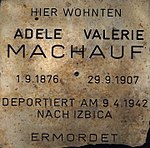
|
Adele Machauf | P 41 | Breitenfurter Strasse 336 |
Adele Machauf (born September 1, 1876) was deported to Izbica on April 9, 1942 and murdered. |
| Valerie Machauf | Valerie Machauf (born September 29, 1907) was deported to Izbica on April 9, 1942 and murdered. | |||

|
Dr. Bertha Neumann (née Kunreuther) |
S 18 | Dirmhirngasse 25 |
Bertha Neumann (born on February 22, 1893) stands in the shadow of her husband Karl in many biographies. Sometimes she is mentioned as a nurse, then again as a doctor. Rather, it is true that Bertha Neumann was one of the first women in Germany to acquire an academic degree in political science / social sciences. In 1920 she published a scientific paper on the health sector.
She was married to the local doctor Karl Neumann from Liesing and was deported with him and their youngest son Klaus on June 24, 1943 with Transport 46i to the Theresienstadt ghetto . Her older descendants, Anna Rosa (1924–2006) and Peter Franz (1927–1986), were sent to England in 1938 and 1939 with Kindertransporte, respectively, and finally emigrated to Brazil. They had five children and seven grandchildren. Bertha Neumann, her husband and her youngest son, just 12 years old, were deported to Auschwitz on October 28, 1944 with Transport Ev and murdered there by the Nazi regime . |
| Dr. Karl Neumann |
Karl Neumann (born on March 22nd, 1890) was a highly respected general practitioner in Liesing , ordained and lived at Schulgasse 10. He married Bertha Neumann (born Kunreuther), a young Jewish woman from Frankfurt am, who was three years his junior Main.
Karl Neuman was a very popular and social community doctor. Allegedly he financed an ambulance for Liesing from his own resources. In particular, he devoted himself to home nursing and childcare. According to the Nuremberg Race Laws, Karl Neumann was a "first degree hybrid" in the Nazi language, which, also because he was a Catholic, offered him little protection, but since he had a Jewish wife, he was under massive pressure exercised to get divorced. Karl Neumann was loyal to his wife Bertha. He was offered full "rehabilitation" several times if he got divorced. The reprisals against Jewish citizens started immediately after Austria was annexed to Germany and Karl Neumann was no longer allowed to work as a doctor. Karl Neumann was deported together with his wife Bertha and his youngest son Klaus on August 19, 1941 to a collective apartment in Porzellangasse, Vienna 9th. During this time he worked as a so-called “patient handler” in the Jewish retirement home in Seegasse. On April 19, 1943, the Neumann family was moved to another collective apartment at Große Stadtgutgasse 24 in the 2nd district. Karl's brother, Gustav Neumann, tried in vain to save his brother and his family and to get them out of the ghetto. After only two months, however, he was deported to the Theresienstadt concentration camp. Allegedly the Neumann family in Theresienstadt played an important role in health care. Despite all this, their fate was sealed six months before the end of the war. On October 28, 1944, the family was transported to Auschwitz and murdered there. The exact date of death is not known. His two oldest descendants survived. The Dr.-Neumann-Gasse in Liesing is named after Karl Neumann. |
|||
| Klaus Neumann | Klaus Neumann (born January 26, 1932) was a 12-year-old student who was gassed by the Nazi regime together with his parents. | |||

|
Ludwig Ordower | S 9 | Kaserngasse 22 |
Ludwig Ordower (born October 15, 1880 in Radziwiłłów) came from Poland. He lived at Kaserngasse 22 in the Mauer district of Liesing and was taken to Buchenwald concentration camp on September 12, 1939 . He was murdered on March 26, 1942. |
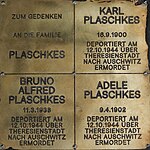
|
Adele Plaschkes | S 50 | Endresstrasse 93-95 |
Adele Plaschkes (born April 9, 1902) was deported to Auschwitz via Theresienstadt on October 12, 1944 and murdered. |
| Karl Plaschkes | Karl Plaschkes (born September 16, 1900) was deported via Theresienstadt to Auschwitz on October 12, 1944 and murdered. | |||
| Bruno Alfred Plaschkes | Bruno Alfred Plaschkes (born March 11, 1938) was deported via Theresienstadt to Auschwitz on October 12, 1944 and murdered. | |||

|
Josef Pluhar | P 52 | Brennergasse 6 |
Josef Pluhar (born March 7, 1911) was deported to Dachau on June 15, 1938 as part of the "police security detention" and murdered in Mauthausen on June 24, 1940. |

|
Bruno Rechnitz | P. 44 | Anton-Freunschlag-Gasse 5 |
Bruno Rechnitz (born July 3, 1910) was deported to Dachau on November 16, 1938 and murdered on February 1, 1939. |

|
Josef Reismann | S 23 | Breitenfurter Strasse 320 |
Josef Reismann (born April 5, 1899) is missing. |
| Margarete Reismann (née Kornitzer) |
Margarete Reismann (born January 25, 1902) is considered missing. | |||

|
Erwin Schleifer | S 8 | Endresstrasse 97 |
The Schleifer family came to Mauer near Vienna before the First World War and lived first at Hauptstrasse 42, later at Hauptstrasse 31 (today Endresstrasse). Erwin Schleifer (born October 5, 1911 in Vienna) was the son of the senior cantor Jakob Schleifer (1873-1930) and his wife Fanny. The family had two sons and a daughter: Hermann (born on September 9, 1909) and Erwin both attended elementary school in Mauer and then the grammar school in Mödling. The fate of her sister Elsa (born in 1902) is unknown. Hermann Schleifer was employed as a manipulator until April 30, 1938, after which he was unemployed and without any income. Erwin worked as an accountant until July 15, 1938, after which he was also unemployed and without income. The family had to leave Mauer on September 24, 1938 and moved from accommodation to accommodation. Hermann Schleifer was able to emigrate to England on April 25, 1939 and lived as Harry T. Sanders in Ireland after the war. Erwin Schleifer also wanted to emigrate and at the end of 1939 tried to get to Palestine with more than 1200 Jews on Danube ships ( Kladovo transport ). The trip ended in Kladovo, Serbia, and in 1941 the refugees were sent to the Šabac concentration camp . On October 12, 1941 - as "atonement" for a partisan attack - all the Jewish men in the camp were shot. Erwin Schleifer was one of them. |
| Fanny Schleifer (née Reis) |
Fanny Schleifer (born June 29, 1881 in Vienna) was the widow of the senior cantor Jakob Schleifer (1873–1930) and received a monthly pension of RM 203 from the Israelitische Kultusgemeinde. On July 1, 1938, this was reduced by 12%. In 1939 she was expelled from Liesing and found refuge in the 2nd district of Vienna (from August to October), then in the 6th (from October 1939 to January 1941) and then again in the 2nd (from January 1941). From there she was deported on September 10, 1942 with Transport IV / 10 from Vienna to the Theresienstadt ghetto . On May 16, 1944, Fanny Schleifer was transferred to Auschwitz with Transport Ea , where she was murdered by the Nazi regime . | |||
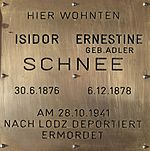
|
Ernestine Schnee (née Adler) |
P. 25 | Breitenfurter Strasse 282 |
Ernestine Schnee (born December 6, 1878 in Hartmanitz ), née Adler, widowed Arnstein, was married to Herman Arnstein for the first time, the couple had two children - their son Emmerich (born December 4, 1905) and their daughter Martha (born January 22, 1910). After the death of her first husband, she married Isidor Schnee in 1917. On October 28, 1941, she and her husband and daughter Martha were taken from the collection point Kleine Sperlgasse 2A, a school in Vienna's 2nd district, to the Aspang train station, and the family was taken to transport 9 (Ernestine Schnees number on the transport was 640 who deported her daughter Martha 641) to the Łódź ghetto . On February 1, 1942, her husband Isidor was murdered by the Nazi regime. On May 15, 1942, she and her daughter Martha Arnstein were also murdered in the Chełmno extermination camp . Her son Emmerich was able to flee in time, and in February 1940 he became the father of a daughter in Tel Aviv . |
| Isidore Snow | Isidor Schnee (born June 30, 1876) married the widow Ernestine Arnstein, born in 1917. Adler, and was abducted on October 28, 1941 with Transport 9 together with his wife and stepdaughter Martha from Vienna to the Łódź ghetto . His prisoner number during the transport was 649. On February 1, 1942, he was murdered by the Nazi regime in Łódź. | |||

|
Siegfried Singer | P. 16 | Breitenfurter Strasse 387 |
Siegfried Singer (born on August 7, 1892) ran a delicatessen shop at Wiener Straße 14 (today: Breitenfurter Straße 383) and lived in Vienna's 3rd district. He was deported on September 7, 1942 and killed in Auschwitz-Birkenau concentration camp. |

|
Quiet Steiner | P 45 | Ketzergasse 7 |
Leiser Steiner (born June 7, 1888) was deported from Drancy to Auschwitz on September 9, 1942 and murdered. |
| Reizler Steiner (née Brodheim) |
Reizler Steiner (born January 17, 1893) was deported from Drancy to Auschwitz on September 9, 1942 and murdered. | |||

|
Johann the devil | S 5 | Anton-Krieger-Gasse 146 |
Johann Teufel (born December 12, 1896) was a carpenter's assistant at Steyr-Daimler-Puch and lived in the Wall district of Liesing . He was arrested in September 1941 for activities for the KPÖ , sentenced to death by the People's Court on November 21, 1942 for “preparing for high treason ” and executed in the Vienna Regional Court on June 16, 1943 using a guillotine . |

|
Ludwig Tichler | T 1 | Kirchenplatz 1 (on the facade of Atzgersdorfer Church) |
Ludwig Tichler (born December 2, 1914) lived at Speisinger Strasse 2 (today Scherbangasse 4) and was deported on September 14, 1942 with Transport 41 Zug Da 227 to Maly Trostinec, where he was murdered on September 18, 1942 . |

|
Eugenie Ungar (nee Schild) |
P. 31 | Auer-Welsbach-Strasse 45 |
Eugenie Ungar (born June 3, 1899) lived in the former Auer Welsbach Villa (Auer-Welsbach-Strasse 239, today: Auer-Welsbach-Strasse 45), she was murdered on January 16, 1945 in Gmunden. |
| Bela Ungar | Bela Ungar (born May 30, 1896 in Torokkanizsa) lived in the former Auer Welsbach Villa (Auer-Welsbach-Strasse 239, today: Auer-Welsbach-Strasse 45), on the death march from Budapest to Austria near Hegyeshalom on May 17 Shot in November 1944. | |||

|
Melanie Valentin (née Amster) |
P. 22 | Breitenfurter Strasse 365 |
Melanie Valentin (born on January 17, 1907) was deported to Lodz on October 18, 1941 and murdered. |

|
Alfred Weisel | P 28 | Charausgasse 48 |
Alfred Weisel (born April 24, 1884 in Teltsch) was an insurance employee, lived in Atzgersdorf, Ziehrergasse 32 (today Charausgasse 48), non-denominational, racially and politically persecuted, from September 1938 in Czechoslovakia, deported to Iglau / Auschwitz-Birkenau, where he died on April 24, 1941. |

|
Elsa Weiss | P 27 | Auer-Welsbach-Strasse 24 |
Elsa Weiss (born April 6, 1878) was deported to Lodz on October 19, 1941 and murdered. |

|
Johanna Weiss | P. 35 | Jaschkagasse 1 |
Johanna Weiss (born May 14, 1872) was deported to Lodz on October 15, 1941 and murdered. |

|
140 Liesinger euthanasia victims | T 3 | Perchtoldsdorfer Strasse 6 |
The memorial plaque bears the names of 140 murdered people with reference to today's Liesing district. According to research by the Stones of Remembrance Association in Liesing, they were murdered in 1940 and 1941.
Many of these victims previously lived in the so-called supply house, a care facility in Liesingen Castle, and in other social institutions in the 23rd district. The plaque also reminds of people who previously lived in Liesing, were then housed in institutions outside Vienna and murdered in Hartheim or other killing centers. It can be assumed that other people were murdered in the course of the euthanasia. Unfortunately, very little is known about most of the victims. There are many elderly people among them, but not only - a girl from Liesingen first came to Gugging and was murdered at the age of 15. |
Laying data
The stones of remembrance in Vienna-Liesing were "opened" on the following days as part of commemorative inspections and events:
November 9, 2013
- Stone 1: Carlbergergasse 39
- Stone 2: Breitenfurter Strasse 316
Ceremony in the Liesing library
17th May 2014
- Stone 3: Mason Lange Gasse 47
- Stone 4: Kroißberggasse 8
Memorial event in the adult education center Mauer
September 10, 2014
- Stone 5: Anton-Krieger-Gasse 28
- Stone 6: Maurer Lange Gasse 85
- Stone 7: Maurer Lange Gasse 62
- Stone 8: Endresstrasse 97
- Stone 9: Kaserngasse 22
November 8, 2014
- Stone 10: Taglieberstrasse 11
- Stone 11: Taglieberstrasse 1
- Stones 12, 13: Endresstrasse 16
Memorial event in the district museum Liesing
17th May 2015
- Panels 1, 2: Kirchenplatz 1 (on the church facade)
Ceremony in front of the parish church Atzgersdorf
June 13, 2015
- Stone 14: Breitenfurter Strasse 350
- Stones 15, 16: Breitenfurter Strasse 383
- Stone 17: Breitenfurter Strasse 389
- Stone 18: Dirmhirngasse 25
Memorial event in the Liesing library
15th September 2015
- Stone 19: Rosenhügelstraße 245
Ceremony of the Socialist Freedom Fighters and the Stones of Remembrance Association in Liesing
19th September 2015
- Stones 20, 21, 22: Breitenfurter Strasse 365
- Stone 23: Breitenfurter Strasse 20
November 7, 2015
- Stone 24: Breitenfurter Strasse 292
- Stone 25: Breitenfurter Strasse 282
- Stone 26: Breitenfurter Strasse 278
Commemoration event for eviction escape in the district museum in Liesing
June 11, 2016
- Stone 27: Auer-Welsbach-Strasse 24
- Stone 28: Charausgasse 48
- Stone 29: Karl-Heinz-Strasse 28
- Stone 30: Auer-Welsbach-Strasse 53
- Stone 31: Auer-Welsbach-Strasse 45
September 9, 2016
- Stone 32: Paul-Katzberger-Gasse 9
- Stone 33: Josef-Kutscha-Gasse 18
- Stone 34: Siebenhirtenstrasse 4
Memorial event in front of the Liesing Agenda Office with the choir "Hor 29. Nov."
5th November 2016
- Stone 35: Jaschkagasse 1
- Stone 36: Schloßgartenstrasse 14
June 24, 2017
- Stone 37: Ruzickagasse 78
- Stone 38: Reiterberggasse 3
- Stone 39: Paminagasse 42
November 11, 2017
- Stone 40: Autofabrikstrasse 1
- Stone 41: Breitenfurter Strasse 336
Lecture by Nina Horaczek on right-wing populism in the Liesing library
April 28, 2018
- Stones 42, 43: Triester Straße 150
- Stone 44: Anton-Freunschlag-Gasse 5
15th May 2018
- Plate 3: Perchtoldsdorfer Straße 6 (memorial plaque in Liesing Palace Park to commemorate the victims of euthanasia)
Opening ceremony of the Liesinger Schlosspark
June 30, 2018
- Stone 45: Ketzergasse 7
- Stone 46: Ketzergasse 60
5th October 2018
- Stone 47: Maurer Lange Gasse 90
- Stone 48: Jesuitensteig 19
Lecture by Wolfgang Neugebauer in the Helmut Zilk House about the euthanasia program of the National Socialists, musical accompaniment: Liesing Music School
October 9, 2018
- Panel 4: Fröhlichgasse 15 (panel on the house facade; previously a memorial stone was moved to the wrong address at Fröhlichgasse 42 on June 30, 2018)
4th June 2019
- Stein 49, 50: Endresstrasse 93-95
- Stone 51: Rudolf-Waisenhorn-Gasse 86
Recital with Martin Auer about sadness and joy, courage and belief in the future in the Liesing library
September 14, 2019
- Stone 52: Brennergasse 6
- Stone 53: Autofabrikstrasse 5
- Stone 54: Carlbergergasse 45
9th November 2019
- Stone 55: Franz-Parsche-Gasse 7
Commemoration event "Lichtsignal Synagoge Liesing" to commemorate the November pogrom 1938 on the former location of the destroyed synagogue Atzgersdorf
swell
- Robert Patocka: Liesinger Victims of National Socialism 1938–1945 , accessed June 2018
- Documentation archive of the Austrian resistance : person search for victims of the Nazi regime , accessed in June 2015
- Yad Vashem : Central database of the names of Holocaust victims , accessed several times from June 2015
See also
- Stumbling, memorial and memorial stones in Austria
- Memorial sites for the victims of National Socialism in Vienna-Liesing
Web links
Individual evidence
- ↑ Katrin Seedig: The Problem with the Symbolic , Die Tageszeitung , February 4, 2015
- ↑ Gisela Czerner. In: The Central Database of Shoah Victims' Names, Yad Vashem , accessed September 19, 2015
- ↑ There are various details about his date of birth, ranging from 1929 to January 17, 1933. The most likely version is given.
- ↑ a b c From the judgment of the People's Court of November 27, 1943: “The defendants Therese Klostermann, Gebrüder Heindl, Franz Hauer, Franz Anderle and Max Schrems are on the home front because they tried as functionaries of the Communist Party until the end of 1942 to decompose, fallen in the back of the hard-fighting front. Such deeds can only be atoned for with death. The National Socialist state would give up itself if it did not permanently exclude people who were consciously working for communism in the fourth year of the war from the German national community. "
- ↑ There are divergent details for both the date of birth (December 6th or December 12th, 1906) and the date of death (October 30th or October 31st, 1940). The most credible or most frequent statements were used.
- ↑ Maurer Kalendarium, connection and changes 1938–1939, 127
- ↑ Letter To The Stars : Dear Isidore , accessed December 18, 2015

